Numerical Evaluation of the Flow within a Rhomboid Tessellated Pipe Network with a 3 × 3 Allometric Branch Pattern for the Inlet and Outlet
Abstract
:1. Introduction
Aim and Scope
2. Numerical Details
2.1. Case Study
2.2. Pipe Networking Inlet/Outlet Construction Conditions
2.3. Pipe Networking Operation Conditions
2.4. Software and Computational Resource
2.5. Numerical Domain Details
2.6. Numerical Models
2.7. Governing Equations
2.8. Turbulence Model
3. Sensitivity Analysis
4. Results
4.1. Velocity Results
4.2. Pressure Drop Results
5. Discussion
6. Conclusions
Author Contributions
Funding
Data Availability Statement
Acknowledgments
Conflicts of Interest
References
- Sumair, F.A.; Mohammad, K.; Mahesh, V.R.; Arshid, N.; Abdul, K.R.; Nabisab, M.M. Recent progress in solar water heaters and solar collectors: A comprehensive review. Therm. Sci. Eng. Prog. 2021, 25, 100981. [Google Scholar]
- Evangelos, B.; Christos, T.; Zafar, S. Investigation and optimization of a solar-assisted pumped thermal energy storage system with flat plate collectors. Energy Convers. Manag. 2021, 237, 114137. [Google Scholar]
- Qureshi, I.A.; Waqas, A.; Ali, M.; Mehmood, A.; Javed, A. Performance evaluation of ORC system using evacuated flat plate Photovoltaic-Thermal collector as an evaporator. Sol. Energy 2021, 230, 859–873. [Google Scholar] [CrossRef]
- Sun, X.; Dai, Y.; Novakovic, V.; Wu, J.; Wang, R. Performance comparison of direct expansion solar-assisted heat pump and conventional air source heat pump for domestic hot water. Energy Procedia 2015, 70, 394–401. [Google Scholar] [CrossRef] [Green Version]
- Li, Y.W.; Wang, R.Z.; Wu, J.Y.; Xu, Y.X. Experimental performance analysis on a direct- expansion solar-assisted heat pump water heater. Appl. Therm. Eng. 2007, 27, 2858–2868. [Google Scholar] [CrossRef]
- Sajid, A.; Yuan, Y.; Hassan, A.; Zhou, J.; Zeng, C.; Yu, M.; Emmanuel, B. Experimental and numerical investigation on a solar direct-expansion heat pump system employing PV/T & solar thermal collector as evaporator. Energy 2022, 254, 124312. [Google Scholar]
- Yao, J.; Liu, W.; Zhao, Y.; Dai, Y.; Zhu, J.; Novakovic, V. Two-phase flow investigation in channel design of the roll-bond cooling component for solar assisted PVT heat pump application. Energy Convers. Manag. 2021, 235, 113988. [Google Scholar] [CrossRef]
- Yao, J.; Zheng, S.; Chen, D.; Dai, Y.; Huang, M. Performance improvement of vapor-injection heat pump system by employing PVT collector/evaporator for residential heating in cold climate region. Energy 2021, 219, 119636. [Google Scholar] [CrossRef]
- Jorge, L.R.; Ignacio, C.M. Mathematical Thermal Modelling of a Direct-Expansion Solar-Assisted Heat Pump Using Multi-Objective Optimization Based on the Energy Demand. Energies 2018, 11, 1773. [Google Scholar]
- Jorge, L.R.; Ignacio, C.M. Thermal capacity: Additional relative efficiency to assess the overall performance of heat pump-based heating systems. Appl. Therm. Eng. 2019, 159, 113841. [Google Scholar]
- Amancio, M.R.; Arturo, G.G.; Marcelo, I.; Nestor, G.H. Theoretical model and experimental validation of a direct-expansion solar assisted heat pump for domestic hot water applications. Energy 2012, 45, 704–715. [Google Scholar]
- Amancio, M.R.; Arturo, G.G.; Marcelo, I.; Nestor, G.H. Experimental validation of a theoretical model for a direct-expansion solar-assisted heat pump applied to heating. Energy 2013, 60, 242–253. [Google Scholar]
- Abhishek, T.; Sushil, K.; Pawan, K.; Sanjeev, K.; Bhardwaj, A.K. A review on the simulation/CFD based studies on the thermal augmentation of flat plate solar collectors. Mater. Today Proc. 2021, 46, 8578–8585. [Google Scholar]
- Badiei, Z.; Eslami, M.; Jafarpur, K. Performance improvements in solar flat plate collectors by integrating with phase change materials and fins: A CFD modeling. Energy 2020, 192, 116719. [Google Scholar] [CrossRef]
- Mohammad, A.; Ben, H.; Andrew, H.; Dominic, C. Determining the Effect of Inlet Flow Conditions on the Thermal Efficiency of a Flat Plate Solar Collector. Fluids 2018, 3, 67. [Google Scholar]
- Gunjo, D.G.; Mahanta, P.; Robi, P.S. Exergy and energy analysis of a novel type solar collector under steady state condition: Experimental and CFD análisis. Renew. Energy 2017, 114, 655–669. [Google Scholar] [CrossRef]
- Primož, P.; Urban, T.; Nada, P.; Boris, V.; Uroš, F.; Andrej, K. Numerical and experimental investigation of the energy and exergy performance of solar thermal, photovoltaic and photovoltaic-thermal modules based on roll-bond heat exchangers. Energy Convers. Manag. 2020, 210, 112674. [Google Scholar]
- Kasuba, S.; Suresh, A.; Kishen, K.R. Experimental and computational analysis of radiator and evaporator. Mater. Today Proc. 2015, 2, 2277–2290. [Google Scholar]
- Sun, X.; Wu, J.; Dai, Y.; Wang, R. Experimental study on roll-bond collector/evaporator with optimized channel used in direct expansion solar assisted heat pump water heating system. Appl. Therm. Eng. 2014, 66, 571–579. [Google Scholar] [CrossRef]
- Aste, N.; Claudio, D.P.; Fabrizio, L. Water flat plate PV–thermal collectors: A review. Sol. Energy 2014, 102, 98–115. [Google Scholar]
- Miglioli, A.; Aste, N.; Del Pero, C.; Leonforte, F. Photovoltaic-thermal solar-assisted heat pump systems for building applications: Integration and design methods. Energy Built Environ. 2023, 4, 39–56. [Google Scholar]
- Aste, N.; Claudio, D.P.; Fabrizio, L. Thermal-electrical optimization of the configuration a liquid PVT collector. Energy Procedia 2012, 30, 1–7. [Google Scholar] [CrossRef] [Green Version]
- Al-Shamani, A.N.; Sopian, K.; Mat, S.; Hasan, H.A.; Abed, A.M.; Ruslan, M.H. Experimental studies of rectangular tube absorber photovoltaic thermal collector with various types of nanofluids under the tropical climate conditions. Energy Convers. Manag. 2016, 124, 528–542. [Google Scholar] [CrossRef]
- Dupeyrat, P.; Ménézo, C.; Rommel, M.; Henning, H.M. Efficient single glazed flat plate photovoltaic–thermal hybrid collector for domestic hot water system. Sol. Energy 2011, 85, 1457–1468. [Google Scholar] [CrossRef]
- Huide, F.; Xuxin, Z.; Lei, M.; Tao, Z.; Qixing, W.; Hongyuan, S. A comparative study on three types of solar utilization technologies for buildings: Photovoltaic, solar thermal and hybrid photovoltaic/thermal systems. Energy Convers. Manag. 2017, 140, 1–13. [Google Scholar] [CrossRef]
- Del Col, D.; Padovan, A.; Bortolato, M.; Dai Prè, M.; Zambolin, E. Thermal performance of flat plate solar collectors with sheet-and-tube and roll-bond absorbers. Energy 2013, 58, 258–269. [Google Scholar] [CrossRef]
- Swapnil, D.; Andrew, A.O. Testing of two different types of photovoltaic–thermal (PVT) modules with heat flow pattern under tropical climatic conditions. Energy Sustain. Dev. 2013, 17, 1–12. [Google Scholar]
- Guarracino, I.; Mellor, A.; Ekins-Daukes, N.J.; Markides, C.N. Dynamic coupled thermal-and-electrical modelling of sheet-and-tube hybrid photovoltaic/thermal (PVT) collectors. Appl. Therm. Eng. 2016, 101, 778–795. [Google Scholar] [CrossRef] [Green Version]
- Santbergen, R.; Rindt, C.M.; Zondag, H.A.; Van Zolingen, R.C. Detailed analysis of the energy yield of systems with covered sheet-and-tube PVT collectors. Sol. Energy 2010, 84, 867–878. [Google Scholar] [CrossRef]
- Touafek, K.; Khelifa, A.; Adouane, M. Theoretical and experimental study of sheet and tubes hybrid PVT collector. Energy Convers. Manag. 2014, 80, 71–77. [Google Scholar] [CrossRef]
- Hosseinzadeh, M.; Salari, A.; Sardarabadi, M.; Passandideh-Fard, M. Optimization and parametric analysis of a nanofluid based photovoltaic thermal system: 3D numerical model with experimental validation. Energy Convers. Manag. 2018, 160, 93–108. [Google Scholar]
- Herrando, M.; Ramos, A.; Zabalza, I.; Markides, C.N. A comprehensive assessment of alternative absorber-exchanger designs for hybrid PVT-water collectors. Appl. Energy 2019, 235, 1583–1602. [Google Scholar] [CrossRef] [Green Version]
- Fudholi, A.; Sopian, K.; Yazdi, M.H.; Ruslan, M.H.; Ibrahim, A.; Kazem, H.A. Performance analysis of photovoltaic thermal (PVT) water collectors. Energy Convers. Manag. 2014, 78, 641–651. [Google Scholar] [CrossRef]
- Aste, N.; Fabrizio, L.; Claudio, D.P. Design, modeling and performance monitoring of a photovoltaic–thermal (PVT) water collector. Sol. Energy 2015, 112, 85–99. [Google Scholar] [CrossRef]
- Buonomano, A.; Francesco, C.; Maria, V. Design, simulation and experimental investigation of a solar system based on PV panels and PVT collectors. Energies 2016, 9, 497. [Google Scholar] [CrossRef]
- Lari, M.O.; Ahmet, Z.S. Design, performance and economic analysis of a nanofluid-based photovoltaic/thermal system for residential applications. Energy Convers. Manag. 2017, 149, 467–484. [Google Scholar] [CrossRef]
- Yu, X.F.; Zhang, C.P.; Teng, J.T.; Huang, S.Y.; Jin, S.P.; Lian, Y.F.; Cheng, C.H.; Xu, T.T.; Chu, J.C.; Chang, Y.J.; et al. A study on the hydraulic and thermal characteristics in fractal tree-like microchannels by numerical and experimental methods. Int. J. Heat Mass Transf. 2012, 55, 7499–7507. [Google Scholar] [CrossRef]
- Wang, G.; Gu, Y.; Zhao, L.; Xuan, J.; Zeng, G.; Tang, Z.; Sun, Y. Experimental and numerical investigation of fractal-tree-like heat exchanger manufactured by 3D printing. Chem. Eng. Sci. 2019, 195, 250–261. [Google Scholar] [CrossRef] [Green Version]
- Zhuang, D.; Yang, Y.; Ding, G.; Du, X.; Hu, Z. Optimization of Microchannel Heat Sink with Rhombus Fractal-like Units for Electronic Chip Cooling. Int. J. Refrig. 2020, 116, 108–118. [Google Scholar] [CrossRef]
- Jing, D.; He, L.; Wang, X. Optimization analysis of fractal tree-like microchannel network for electroviscous flow to realize minimum hydraulic resistance. Int. J. Heat Mass Transf. 2018, 125, 749–755. [Google Scholar] [CrossRef]
- Geoffrey, W.; James, B.; Brian, E. A general model for the origin of allometric scaling laws in biology. Science 1997, 276, 122–126. [Google Scholar]
- Kittinan, B.; Mehrdad, M.; Javad, M.N.; Rasool, A.; Omid, M.; Ahmet, S.D.; Ho, S.A.; Somchai, W. Prediction of battery thermal behaviour in the presence of a constructal theory-based heat pipe (CBHP): A multiphysics model and pattern-based machine learning approach. J. Energy Storage 2022, 48, 103963. [Google Scholar]
- Bejan, A.; Lorente, S. Constructal theory of generation of configuration in nature and engineering. J. Appl. Phys. 2006, 100, 5. [Google Scholar] [CrossRef] [Green Version]
- Bejan, A. Constructal-theory network of conducting paths for cooling a heat generating volume. Int. J. Heat Mass Transf. 1997, 40, 799–816. [Google Scholar] [CrossRef]
- Kittipong, S.; Mehrdad, M.; Jatuporn, K.; Ahmet, S.D.; Ho, S.A.; Omid, M.; Somchai, W. Novel design of a liquid-cooled heat sink for a high performance processor based on constructal theory: A numerical and experimental approach. Alex. Eng. J. 2022, 61, 10341–10358. [Google Scholar]
- Tesař, V. Bifurcating channels supplying “numbered-up” microreactors. Chem. Eng. Res. Des. 2011, 89, 2507–2520. [Google Scholar] [CrossRef]
- Johansson, E.; Moohammed, W.Y. Wind comfort and solar access in a coastal development in Malmö, Sweden. Urban Clim. 2020, 33, 100645. [Google Scholar] [CrossRef]
- Nguyen, T.D.; Ha, M.B. Computational fluid dynamic model for smoke control of building basement. Case Stud. Chem. Environ. Eng. 2023, 7, 100318. [Google Scholar] [CrossRef]
- Moaveni, S. Finite Element Analysis Theory and Application with ANSYS, 2nd ed.; Pearson Education: Hoboken, NJ, USA, 2011; pp. 5–8. [Google Scholar]
- Patankar, S.V. Numerical Heat Transfer and Fluid Flow; Hemisphere Publishing Corporation: New York, NY, USA, 1980. [Google Scholar]
- Walter, H. Dynamic simulation of natural circulation steam generators with the use of finite-volume-algorithms—A comparison of four algorithms. Simul. Model. Pract. Theory 2007, 15, 565–588. [Google Scholar] [CrossRef]
- Nelson, O.M.; Juan, I.J.; Roberto, C.C. An approach to accelerate the convergence of SIMPLER algorithm for convection-diffusion problems of fluid flow with heat transfer and phase change. Int. Commun. Heat Mass Transf. 2021, 129, 105715. [Google Scholar]
- Yin, R.; Chow, W.K. Comparison of four algorithms for solving pressure velocity linked equations in simulating atrium fire. Int. J. Archit. Sci. 2003, 4, 24–35. [Google Scholar]
- Schnipke, R.J. A Streamline Upwind Finite-Element Method for Laminar and Turbulent Flow; University of Virginia: Charlottesville, VA, USA, 1986. [Google Scholar]
- Garg, H.; Agarwal, R. Some aspects of a PV/T collector/forced circulation flat plate solar water heater with solar cells. Energy Convers. Manag. 1995, 36, 87–99. [Google Scholar] [CrossRef]
- White, F.M. Fluid Mechanics, 5th ed.; McGraw-Hill Book Company: Boston, MA, USA, 2003. [Google Scholar]
- Colebrook, C.F.; Blench, T.; Chatley, H.; Essex, E.H.; Finniecome, J.R.; Lacey, G.; Macdonald, G. Correspondence. turbulent flow in pipes, with particular reference to the transition region between the smooth and rough pipe laws. (includes plates). J. Inst. Civ. Eng. 1939, 12, 393–422. [Google Scholar] [CrossRef]
- Fox, R.W.; McDonald, A.T.; Mitchell, J.W. Fox and McDonald’s Introduction to Fluid Mechanics; John Wiley & Sons: Hoboken, NJ, USA, 2020. [Google Scholar]
- Gabriela, L.; Andrew, K.; Amir, K. Experimental Techniques against RANS Method in a Fully Developed Turbulent Pipe Flow: Evolution of Experimental and Computational Methods for the Study of Turbulence. Fluids 2022, 7, 78. [Google Scholar]
- Milad, A.; Paola, G.; David, V.; Carlo, G. Numerical Study of Flow Downstream a Step with a Cylinder Part 1: Validation of the Numerical Simulations. Fluids 2023, 8, 55. [Google Scholar]
- Yoon, G.H. Topology optimization method with finite elements based on the k-ε turbulence model. Comput. Methods Appl. Mech. Eng. 2020, 361, 112784. [Google Scholar] [CrossRef]
- Brice, R.; Jonas, K.J.; Svenn, K.H.; Wiebke, B.M. Analysis of Cold Air Recirculation in the Evaporators of Large-Scale Air-Source Heat Pumps Using CFD Simulations. Fluids 2020, 5, 186. [Google Scholar]
- Launder, B.; Spalding, D. Mathematical Models of Turbulence; Academic Press: London, UK, 1972. [Google Scholar]
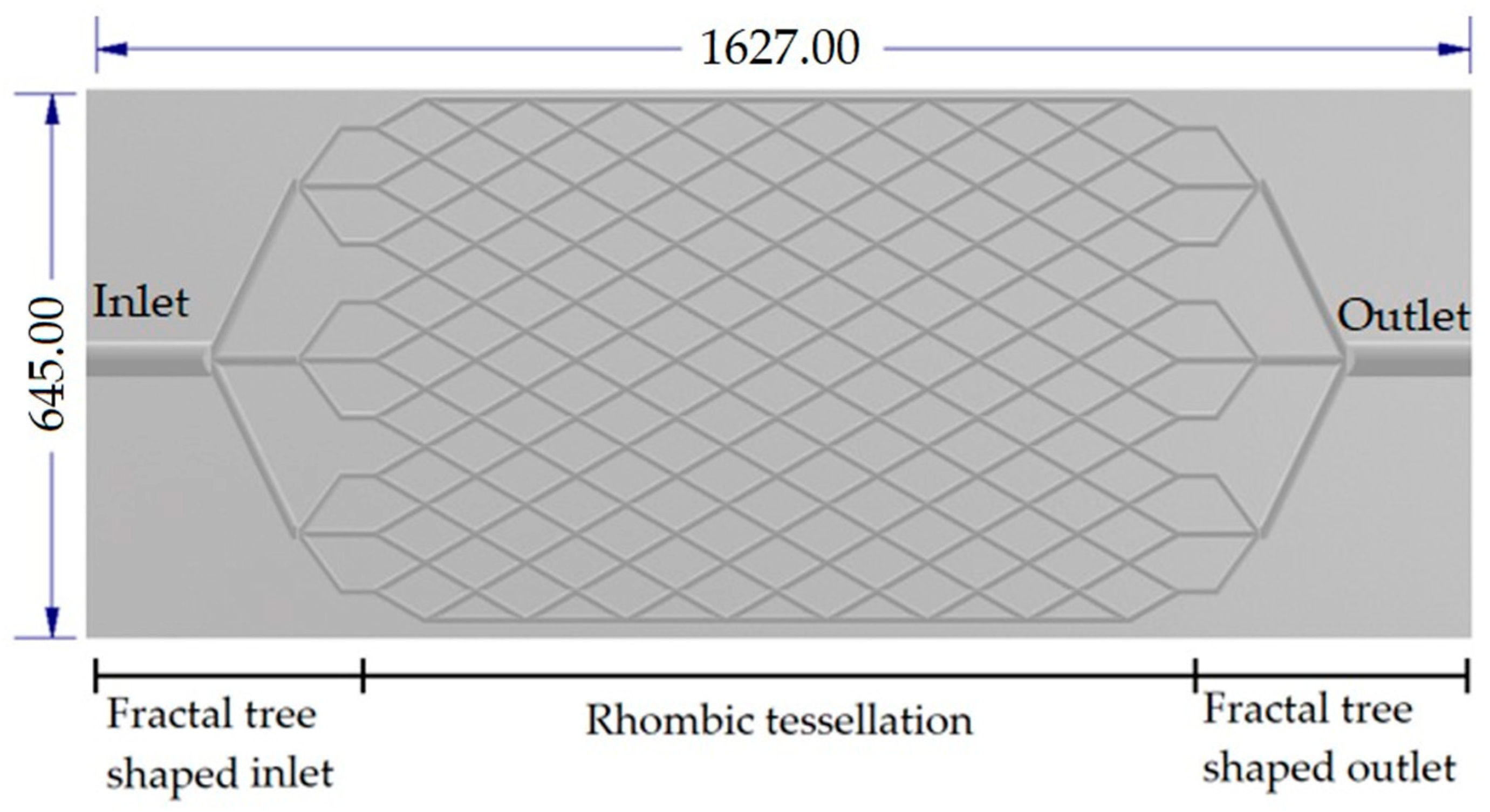
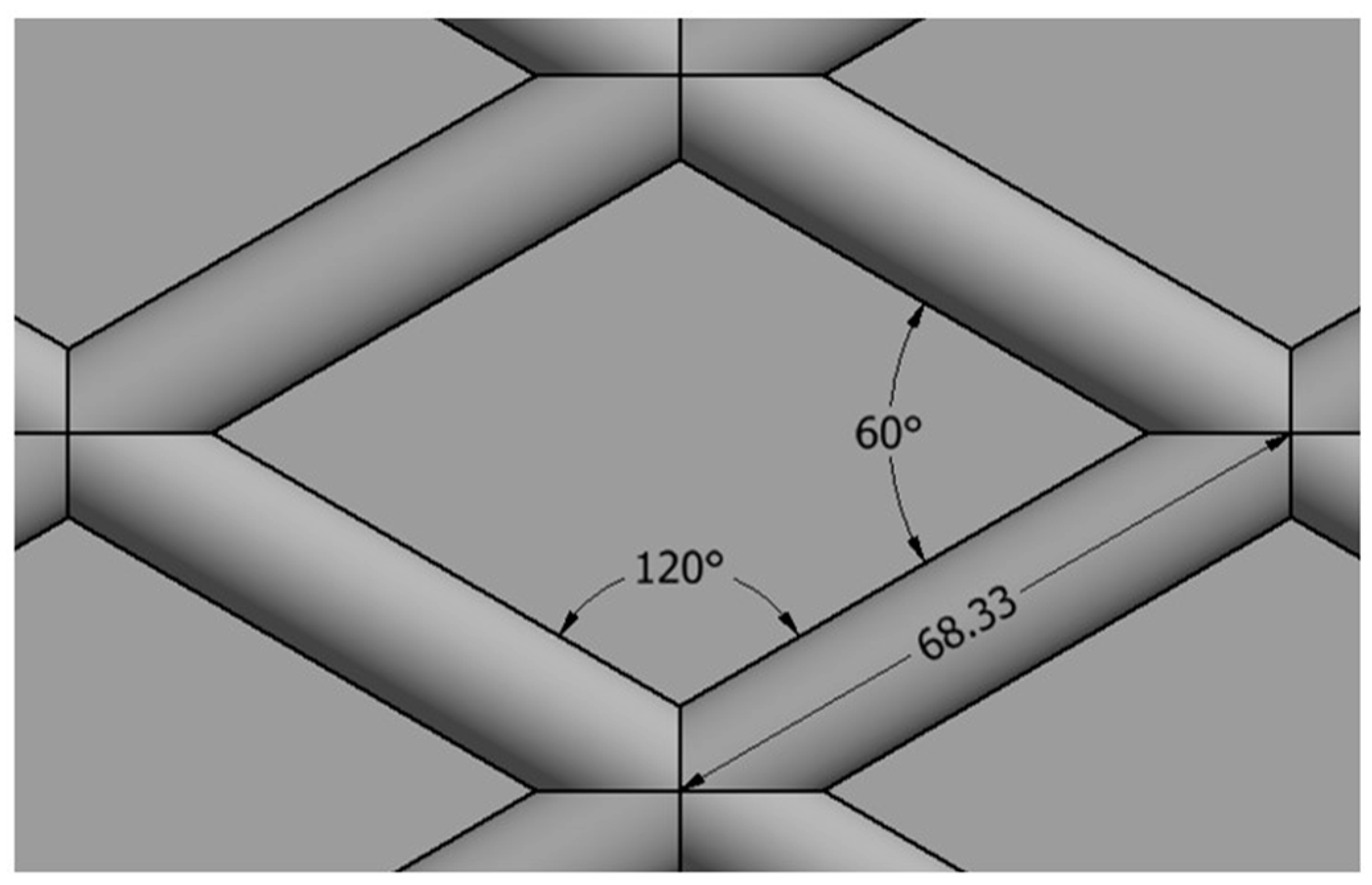

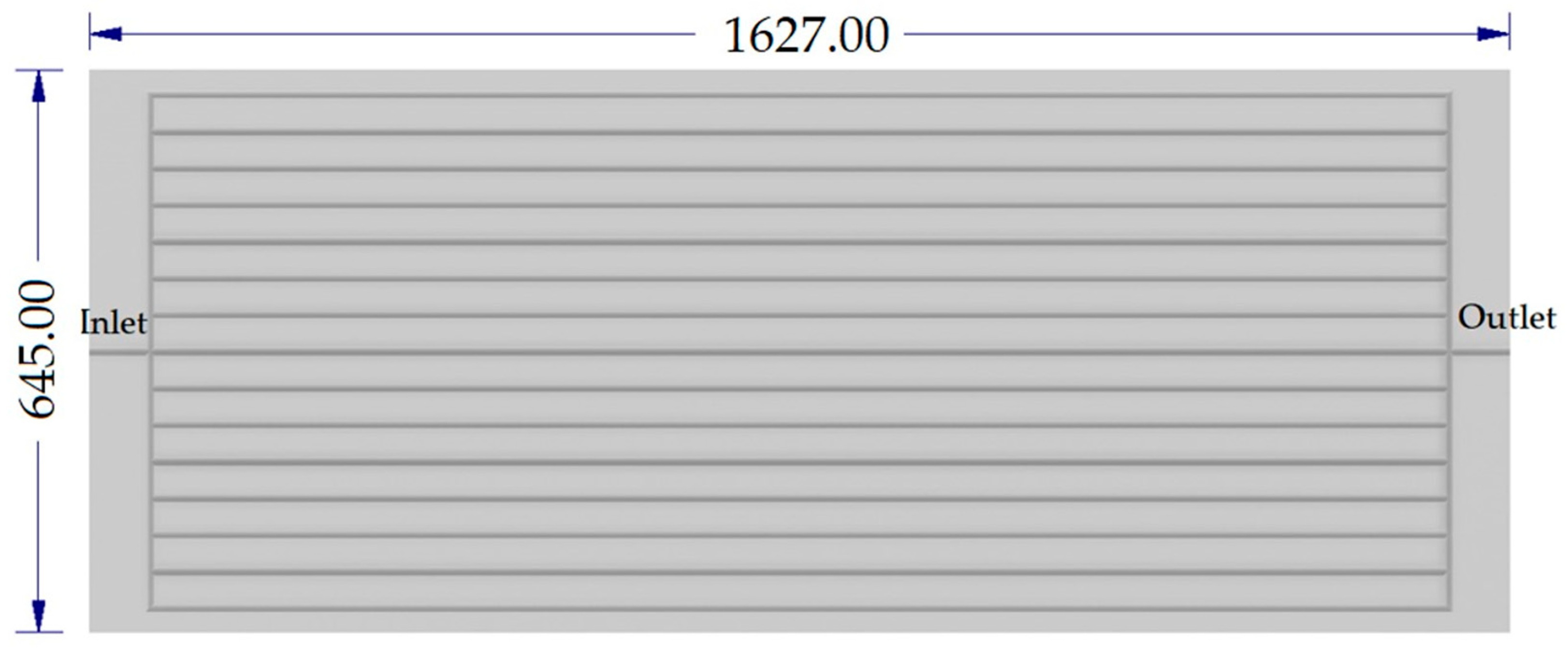
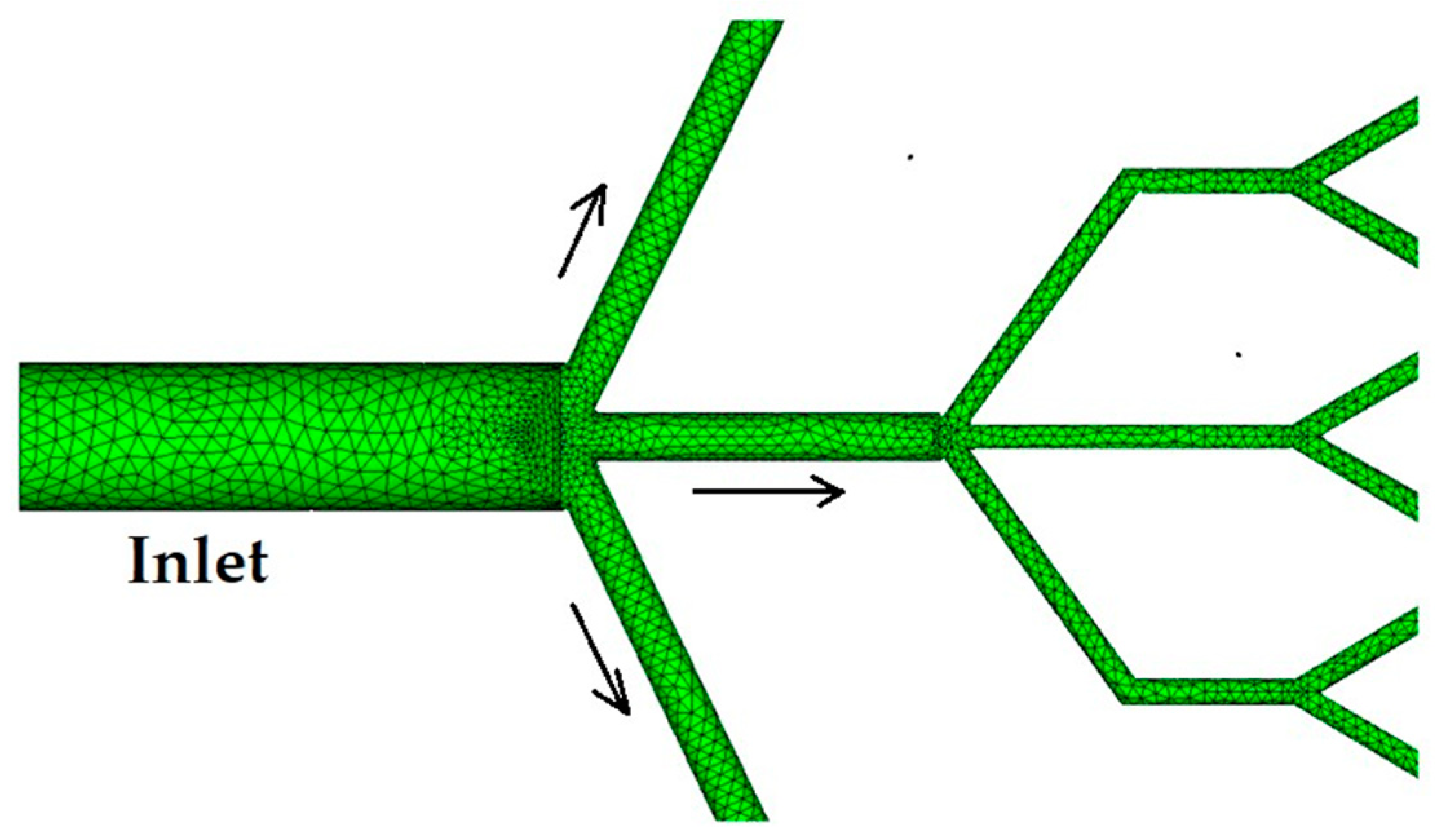

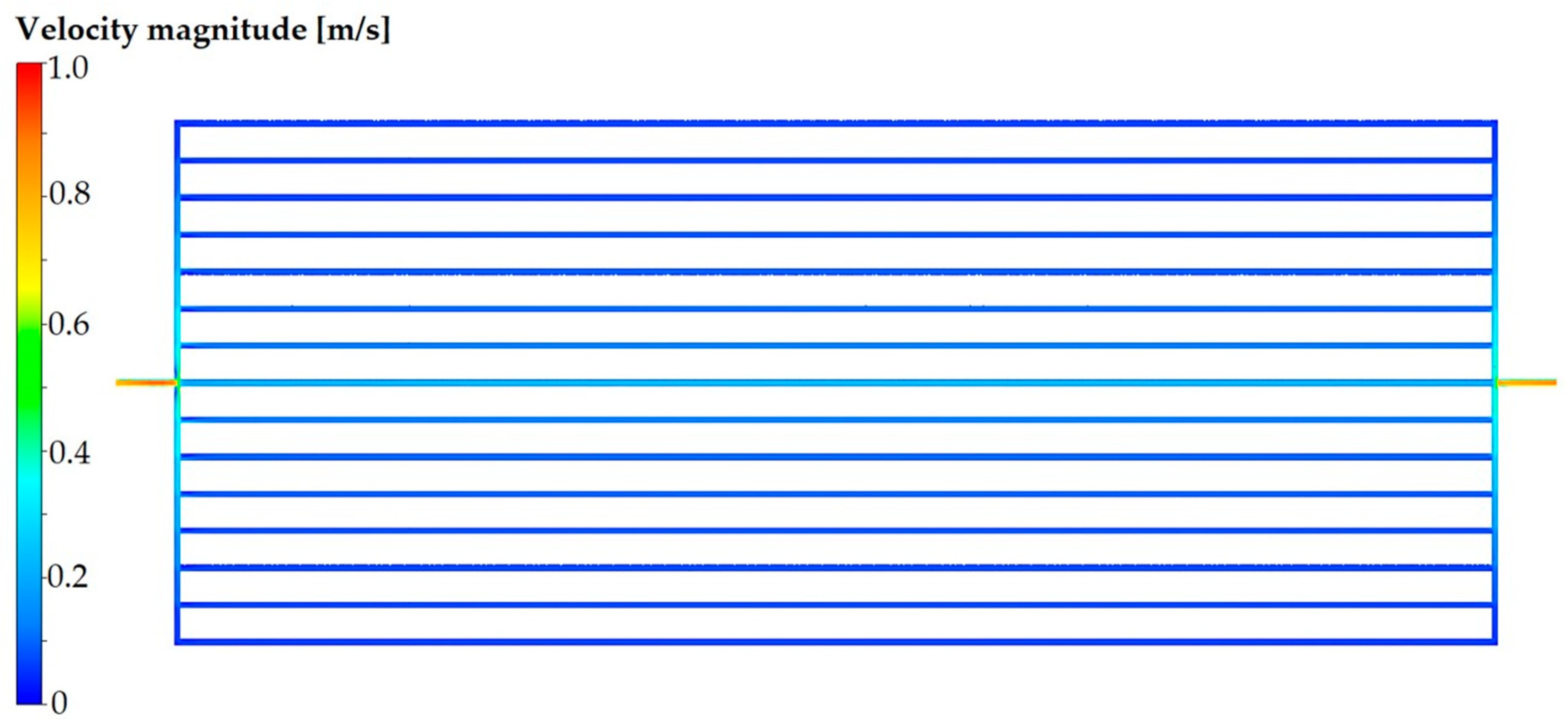

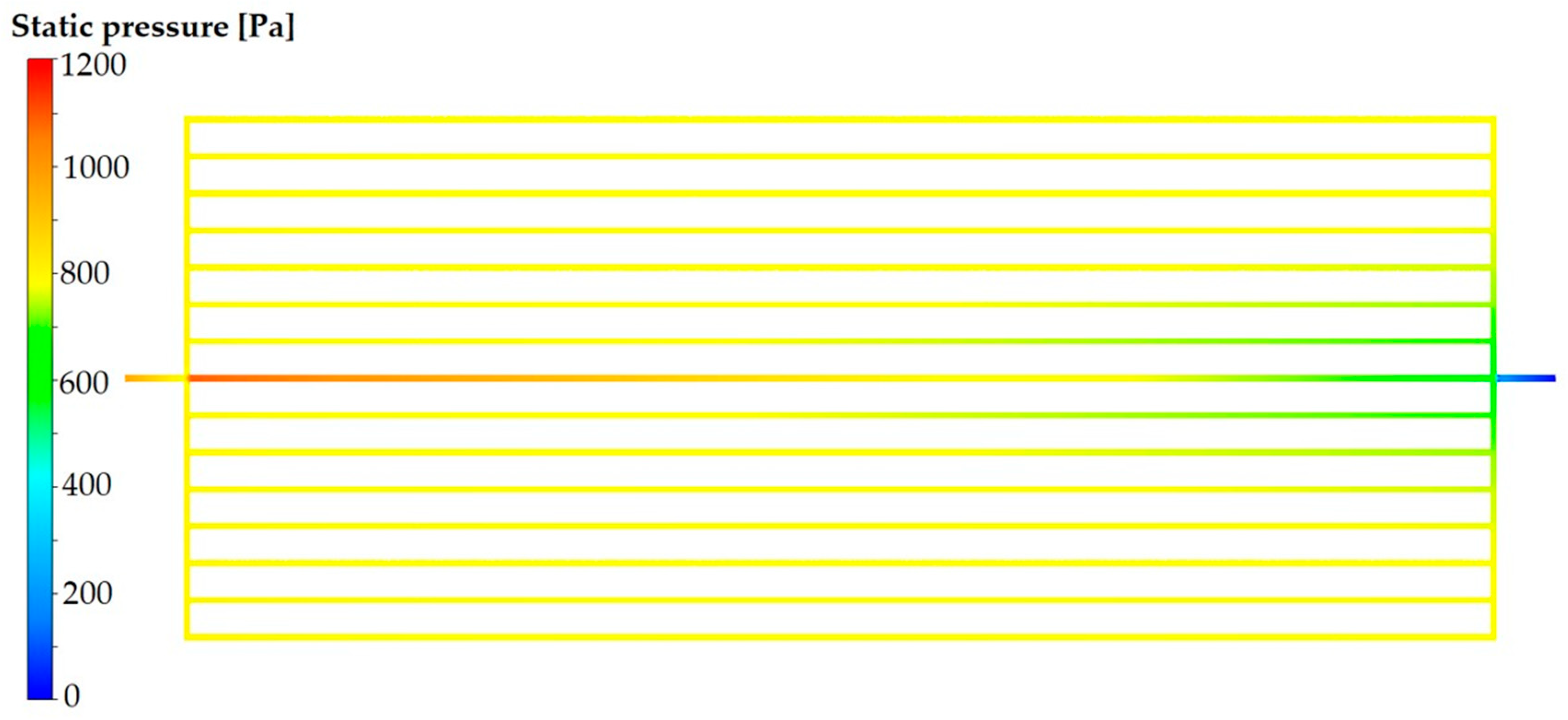
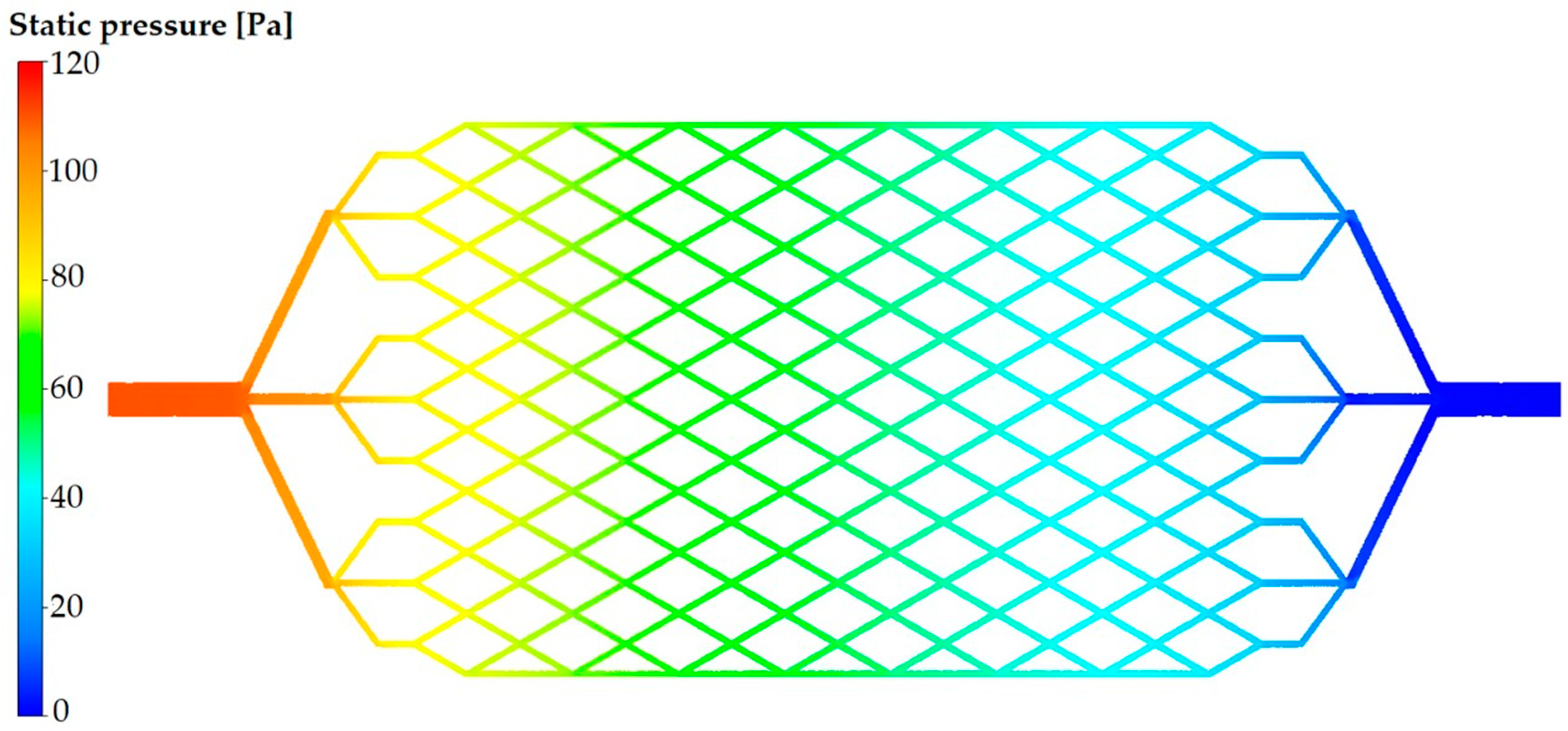
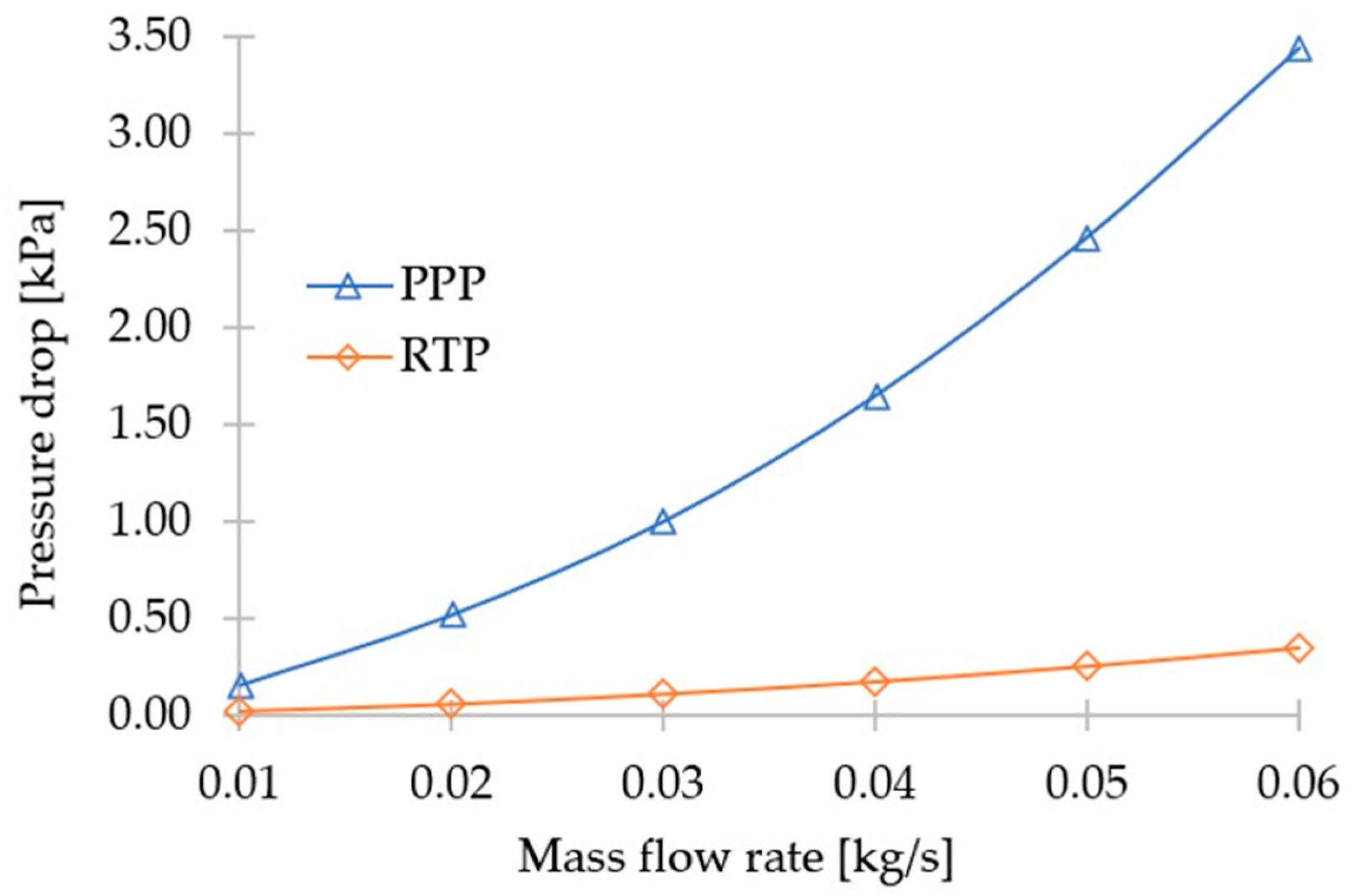

| Diameter [mm] | Length [mm] | |
|---|---|---|
| Inlet line | 39.6 | 148 |
| First Branch | 13.2 | 229 |
| Second Branch | 7.3 | 130 |
| PPP | RTP | |
|---|---|---|
| Material | Copper | Copper |
| Length [mm] | 1627 | 1627 |
| Width [mm] | 645 | 645 |
| Thickness [mm] | 1 | 1 |
| Area [m2] | 1.049 | 1.049 |
| Pipe area [%] | 20.81 | 20.96 |
| Hydraulic diameter [mm] | 7.3 | 39.6, 13.2, 7.3 |
| Volume [m3] | 0.002 | 0.002 |
| Property | Value |
|---|---|
| Density, [kg/m3] | 998.2 |
| Viscosity, [kg/(m·s)] | 0.01003 |
| Mesh 1 | Mesh 2 | Mesh 3 | Mesh 4 | Mesh 5 | ||
|---|---|---|---|---|---|---|
| Pipe networking with rhombic tessellation | ||||||
| Number of nodes | 215,936 | 360,480 | 661,595 | 728,324 | 1,020,862 | |
| Number of elements | 648,909 | 1,186,953 | 2,478,962 | 2,796,240 | 4,102,085 | |
| Pressure drop [Pa] | 27.8 | 24.6 | 22.3 | 21.9 | 21.8 | 22.49 |
| Pipe networking with parallel pipe | ||||||
| Number of nodes | 252,426 | 671,693 | 932,002 | 990,800 | 1,195,763 | |
| Number of elements | 611,386 | 1,829,540 | 2,655,701 | 2,828,856 | 3,389,378 | |
| Pressure drop [Pa] | 210.8 | 179.3 | 151.3 | 150.6 | 150.1 | 147.9 |
| [kg/s] | RTP | PPP |
|---|---|---|
| 0.01 | 320.6 | 1738.9 |
| 0.02 | 641.1 | 3477.9 |
| 0.03 | 961.7 | 5216.8 |
| 0.04 | 1282.3 | 6955.8 |
| 0.05 | 1602.8 | 8694.7 |
| 0.06 | 1923.4 | 10,433.7 |
Disclaimer/Publisher’s Note: The statements, opinions and data contained in all publications are solely those of the individual author(s) and contributor(s) and not of MDPI and/or the editor(s). MDPI and/or the editor(s) disclaim responsibility for any injury to people or property resulting from any ideas, methods, instructions or products referred to in the content. |
© 2023 by the authors. Licensee MDPI, Basel, Switzerland. This article is an open access article distributed under the terms and conditions of the Creative Commons Attribution (CC BY) license (https://creativecommons.org/licenses/by/4.0/).
Share and Cite
Rodríguez-Rivera, R.; Carvajal-Mariscal, I.; Terres-Peña, H.; De la Cruz-Ávila, M.; De León-Ruiz, J.E. Numerical Evaluation of the Flow within a Rhomboid Tessellated Pipe Network with a 3 × 3 Allometric Branch Pattern for the Inlet and Outlet. Fluids 2023, 8, 221. https://doi.org/10.3390/fluids8080221
Rodríguez-Rivera R, Carvajal-Mariscal I, Terres-Peña H, De la Cruz-Ávila M, De León-Ruiz JE. Numerical Evaluation of the Flow within a Rhomboid Tessellated Pipe Network with a 3 × 3 Allometric Branch Pattern for the Inlet and Outlet. Fluids. 2023; 8(8):221. https://doi.org/10.3390/fluids8080221
Chicago/Turabian StyleRodríguez-Rivera, René, Ignacio Carvajal-Mariscal, Hilario Terres-Peña, Mauricio De la Cruz-Ávila, and Jorge E. De León-Ruiz. 2023. "Numerical Evaluation of the Flow within a Rhomboid Tessellated Pipe Network with a 3 × 3 Allometric Branch Pattern for the Inlet and Outlet" Fluids 8, no. 8: 221. https://doi.org/10.3390/fluids8080221






